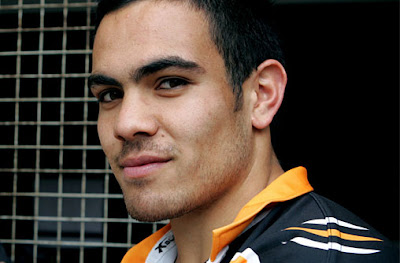What does the perfect career consist of? Actually making the transition into a top grade squad? Winning an incredible premiership with your debut club? Representing your country of birth? Playing proudly in the Tri-Nations? Participating in the European tour? Playing the game you love until you reach a decent age?
Well, aside from an unfortunate hinderance of injuries, humble Halatau boasts all of this.
Debuting in round 13 of 2003, Halatau was an influencial player, participating in the Tigers' first grand final win against the North Queendsland Cowboys in 2005. During his time at Concord, he also played 15 tests for New Zealand, from 2004 to 2009. After 128 games and a total of 68 points in the black and gold jersey, Halatau moved to the Canterbury Bulldogs on a 3 year deal in 2010. Playing more than 200 first grade games over his career, the utility turned 31 in January, but this didn't prevent him from re-signing to the Wests Tigers.
In first appearance in Tigers' colours since 2009, Halatau broke his ankle and tore ligaments during the pre-season trial win against the Penrith Panthers early February. Expected to be out for at least 5 months, he surprised everyone with his positive attitude and speedy recovery. Peter Moussa, the Wests Tigers Head Physiotherapist, today stated that Halatau had begun full training a couple of weeks ago and that the New Zealand born beast is named to play in the NSW Cup team this weekend.
Having previously played with the club for many years and being one of the remaining members from the Wests Tigers’ 2005 premiership success, Halatau's return to the club will be greatly welcomed by all. Adding invaluable experience to a relatively young squad, his utility value is one that will no doubt be utilised following his much awaited return.
1. http://hoseagear.blogspot.com.au/2012_01_01_archive.html
2. http://www.theaustralian.com.au/sport/nrl/dene-halatau-re-signs-with-bulldogs/story-fnca0von-1226423469595
3. http://www.weststigers.com.au/content/tigers/club/news/2013/12/09/2014-nrl-draw-preview-dene-halatau.html
Debuting in round 13 of 2003, Halatau was an influencial player, participating in the Tigers' first grand final win against the North Queendsland Cowboys in 2005. During his time at Concord, he also played 15 tests for New Zealand, from 2004 to 2009. After 128 games and a total of 68 points in the black and gold jersey, Halatau moved to the Canterbury Bulldogs on a 3 year deal in 2010. Playing more than 200 first grade games over his career, the utility turned 31 in January, but this didn't prevent him from re-signing to the Wests Tigers.
In first appearance in Tigers' colours since 2009, Halatau broke his ankle and tore ligaments during the pre-season trial win against the Penrith Panthers early February. Expected to be out for at least 5 months, he surprised everyone with his positive attitude and speedy recovery. Peter Moussa, the Wests Tigers Head Physiotherapist, today stated that Halatau had begun full training a couple of weeks ago and that the New Zealand born beast is named to play in the NSW Cup team this weekend.
Having previously played with the club for many years and being one of the remaining members from the Wests Tigers’ 2005 premiership success, Halatau's return to the club will be greatly welcomed by all. Adding invaluable experience to a relatively young squad, his utility value is one that will no doubt be utilised following his much awaited return.
1. http://hoseagear.blogspot.com.au/2012_01_01_archive.html
2. http://www.theaustralian.com.au/sport/nrl/dene-halatau-re-signs-with-bulldogs/story-fnca0von-1226423469595
3. http://www.weststigers.com.au/content/tigers/club/news/2013/12/09/2014-nrl-draw-preview-dene-halatau.html







